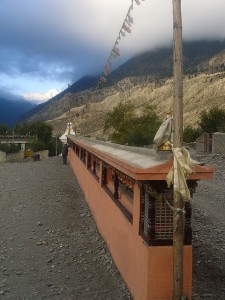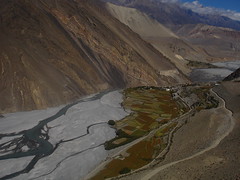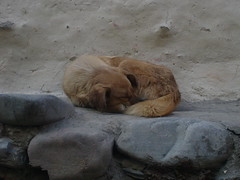 We leave Marpha the next morning under a slate grey sky that is heavy and strangely silent.
We leave Marpha the next morning under a slate grey sky that is heavy and strangely silent.
Pulling out of town we pass a set of prayer wheels.
The coloured prayer flags are ragged and faded and they flutter forlornly in the air.
For some reason I am transfixed by them but as I stop to admire them, I become aware of a man wandering about, muttering to himself.
He’s barefoot but wears a thick padded jacket and sweater, jeans and a floppy white hat (the type you’d buy for the beach).
He seems oblivious to everyone around him. All there is, is the wall of prayer wheels which he circulates over and over again, turning the wheels and muttering.
At first I assume he is in some beatific trance, experiencing some religious rapture that I will never know in my own, atheistic life.
“So many drunks.”
It’s Laxman.
He’s watching me watching the man and seems slightly ashamed at the spectacle.
It’s eight a.m. and here is this man, lost in an alcoholic stupor.
I look again, this time noticing that he is lurching and stumbling, that this indeed is , no religious trance, but simply a drunken man, fumbling and playing with the wooden wheels.
I’ve seen many a drunken bum in my lifetime sauntering about the streets of Glasgow and Amsterdam, but for some reason this man gets to me more.
It’s the day before. It’s still with me, that overwhelming solitude, that vast isolation. The fear that it induces.
How do people manage to live here, is what I’d asked myself yesterday.
But watching him as he stumbles around, I realise very quickly, that some of them don’t. Solace doesn’t always come from the sound of water under paving stones. Sometimes it can only come in a bottle.
I can honestly say that I don’t think I have ever seen a lonelier person in my life before, than that man.
As we turned and pulled out of town, heading to Jomsom, I don’t even think he noticed any of us were there…
Jomsom turns out to consist, for the most part, of a wide main street lined with hotels, shops and multiple air line companies offering flights to Pokhara from the local airfield. It’s a hub of activity and compared to Marpha it seems huge, even for a city girl like myself.
Our main aim of the morning is to arrange for our flight tickets out in a few days.
For don’t be fooled. Despite the seeming remoteness you still need to book and pay for your return flight in advance.
So it is we find ourselves in a hotel lobby that doubles as the ticket office for the wonderfully named Shangrila Air
I feel a little sad as we make the booking. Shangrila, that mythical Himalayan utopia, and here we are, preparing to be whisked away from it all in a few days time.
But there’s no time to dwell on that for now, because ahead of us is another couple of hours walking through the grey dusty river bed and on to Kagbeni.
In the desolation and wind, it’s a case of getting your head down and simply walking. The wind and the dust leave you unwilling to raise your head and take in the scenery. All there is, is a relentless greyness and a stony riverbed under foot for a path.
It’s possible to take a higher trail away from the river but, at this time of year, with the river dry, it’s flatter and easier simply to stay down low and walk.
After the bleakness of this stretch of the trail, Kagbeni comes as something of a surprise. It seems so arid here, so dry and dusty and incapable of sustaining life, that you get the impression Kagbeni is an illusion. Some sort of Nepali mirage.

Yet there it is, a little oasis of plenty, fed and nurtured, presumably, from the silt washed down from the mountains.
As we pulled into the guesthouse I noticed with disbelief a little garden that had been cultivated by the owners and which proudly boasted a thriving crop of pumpkins, corn, lettuce and carrots. Behind the garden, small plots of millet could be seen sprouting up as if oblivious to the bleakness of their surroundings.
In the streets, small calves wandered freely, their necks decorated with little colourful collars. They seemed unperturbed by us gawping and delighted tourists, as if their presence in the narrow alleyways and mazelike warrens was nothing out of the ordinary.
It’s a ramshackle little place, is Kagbeni. A little run down – the roofs of some buildings are collapsing, and those that remainstanding are sometimes squint as if, like trees, they have come to lean out of the wind, to shrink from the elements.
The little warren of streets seem to lead in circles and, just when you think you are lost or going nowhere, it opens out at a lovely little temple, and offers views beyonf of the forbidden territory of Upper Mustang.
This is as far as you can go now without a special permit and government permission. A garish yellow sign officiallyinforms visitors that this is the end of the line. You can stand at the gate and look out across the valley, but you cannot pass.
Can any place be more mysterious or tantalising I wonder?
 And yet, for all that, Kagbeni itself is charming enough to compete with the allure of forbidden Upper Mustang.
And yet, for all that, Kagbeni itself is charming enough to compete with the allure of forbidden Upper Mustang.
Wandering the tiny alleys it all seems so relaxed, so slow, so separate from the world. Even the animals are strangely “out of this world”.
On my walk, I pass a dog, asleep on a wall and curled up like a cat.
Zen-like and oblivious, he sums up, in one image what no words can achieve. For me, he simply is Kagbeni.